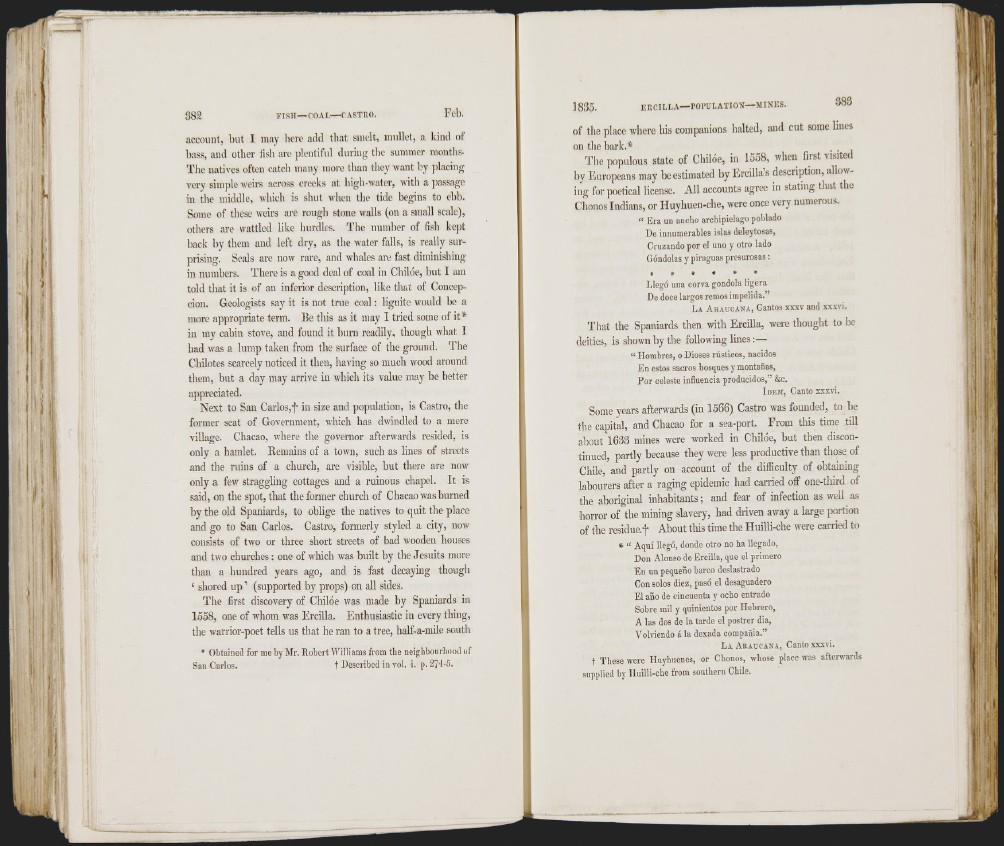
i t. 1
acconiit, but I may here add that smdt, mullet, a kind of
bass, and other fish are plentiful during the summer months-
The natives often catch many more than tliey want hy placing-
very simple weirs across creeks at high-water, with a passage
in the middle, which is shut when the tide begins to ebb.
Some of these weirs are rough stone walls (on a small scale),
others ;u-e wattled like hurdles. The number of fisli kept
back by them aud left dry, as the water falls, is really surprising.
Seals are now rare, and whales are fast diminishing
in numbers. There is a good deal of coal in Chiloe, but I am
told that it is of an inferior description, like that of Concepcion.
Geologists say it is not true coal; lignite would he a
more appropriate term. Be this as it may I tried some of it*
ill my cabin stove, and found it burn readily, though what I
had was a lump taken from the surface of the ground. The
Chilotes scarcely noticed it then, having so much wood around
them, but a day may arrive in which its value may he better
appreciated.
Next to San Carlos,-f- in size and population, is Castro, tlie
former seat of Government, whicli has dwindled to a mere
villaae. Chacao, where the O ' Ogovernor afterwards resided, is
only a hamlet. Bemains of a town, such as lines of streets
and the ruins of a church, are visible, but there are now
only a few straggling cottages and a ruinous chapel. It is
said, on the spot, that the former church of Chacao was burned
hy the old Spaniards, to oblige the natives to quit the place
and go to San Carlos. Castro, formerly styled a city, now
consists of two or three short streets of bad wooden houses
and two churches : one of which was built by the Jesuits more
than a hundred years ago, and is fast decaying though
‘ shored up ’ (supported by props) on all sides.
The first discovery of Chilóe was made by Spaniards in
1558, one of whom was Ercilla. Enthusiastic in every thing,
the warrior-poet tells us that he ran to a tree, half-a-mile south
• Obtained for me by Mr. Robert Williams from tbe neigbbourboo J of
San Carlos. t Described in vol. i. p. 274-5.
of the place where his companions halted, and cut some lines
on tlie hark.* . .
The populous state of Chilóe, in 1558, when first visited
hy Europeans may be estimated hy Ercilla’s description, allowing
for poetical license. All accounts agree in stating that the
Oionos Indians, or Huyhuen-che, were once very numerous.
“ Era un ancho archipiélago poblado
De innumerables islas deleytosas,
Cruzando por el uno y otro lado
Góndolas y piraguas presurosas:
* * * * * *
Llegó una corva gondola ligera
De doce largos remos impelida.”
L a A r a u c a n a , Cantos xxxv and xxxvi.
That the Spaniards then with Ercilla, were thought to bo
deities, is shown by the following lines:—
“ Hombres, o Dioses rústicos, nacidos
En estos sacros bosques y montañas.
Por celeste influencia producidos,” &c.
I d e m , Canto x x x v i .
Some years afterwards (in 1566) Castro was founded, to he
the capital, and Chacao for a sea-port. From this time till
ahout 1633 mines were worked in Chilóe, but then discontinued,
partly because they were less productive than those of
Chile, and partly on account of the difficulty of obtaining
labourers after a raging epidemic had carried off one-tliird of
the aboriginal inhabitants; and fear of infection as well as
horror of the mining slavery, had driven away a large portion
of the residue.! About this time the Huilli-che were carried to
* “ Aquí llegó, donde otro no ha llegado,
Don Alonso de Ercilla, que el primero
En un pequeño barco deslastrado
Con solos diez, pasó el desaguadero
El año de cincuenta y ocho entrado
Sobre mil y quinientos por Hebrero,
A las dos de la tarde el posü-er dia.
Volviendo ála dexada compañía.”
L a A r a u c a n a , Canto xxxvi.
t These were Huyhuenes, or Chonos, whose place was afterwards
supplied by Huilli-che from southern Chile.
I
il {